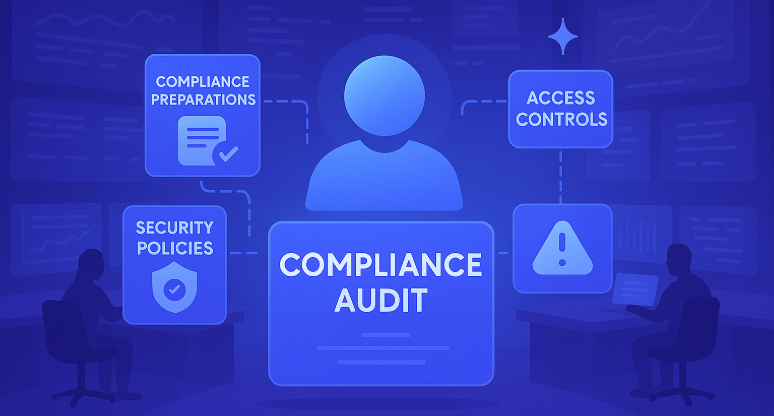Meeting regulatory compliance standards can be a huge pain, especially when you’re moving at lightning speed.
Across sectors, companies have to meet compliance standards. These standards are set by governments or industry groups to conduct business securely and in good standing. If these companies can keep the faith, they can reap the benefits of their compliance efforts.
When you figure out how to conduct an internal audit, you can make sure it meets the relevant standards and demonstrate compliance to the public.
- But what is a compliance audit?
- When is one necessary?
- Who conducts the audit itself?
- And who is responsible for any remediation steps uncovered in the process?
When you can figure out the answers to questions about compliance auditing, you can make the process of meeting compliance faster and smoother. You’ll shorten your time to market. And you won’t have to sacrifice due diligence.
Key Takeaways
- Compliance audits are comprehensive evaluations of your organization’s policies, systems, and practices to make sure they meet industry or government standards.
- You need clear internal policies, access controls, documentation, and the right tools to streamline the audit process and reduce your risk of failure.
- Whether the result is a pass or a list of remediation steps, audits can help you identify gaps, improve processes, and ultimately build more secure and compliant operations.
How to Conduct a Compliance Audit: The Real Deal
A compliance audit is a rigorous and comprehensive review of an organization’s technology and policies. The goal is to determine whether or not a company meets regulatory standards. The result of the review is an audit report. It describes and evaluates your organization’s:
- Compliance preparations
- Access controls
- Security policies
- Risk management
The exact audit targets and criteria change according to a few factors. You’ve got to consider whether the company is public or private, what type of data your company handles, and whether or not your company’s data is sensitive.
Independent auditing firms usually run compliance audits, so there’s no question of conflicts of interest.
Receiving a positive result from an audit like this can reassure your company that your security and integrity efforts are sufficient. It demonstrates to potential customers that your business takes these standards seriously. It also shows that you meet every compliance requirement and that you have no compliance issues.
On the other hand, an unsatisfactory audit result could incur fines and other penalties. You may also lose business if your reputation is damaged.
Types of Compliance Audits
There are a number of audits that could be relevant to your business.
- Health Insurance Portability and Accountability Act (HIPAA) audits make sure you’re storing and transmitting personal health information to preserve patient privacy.
- Payment Card Industry Data Security Standard (PCI DSS) audits deal with how your company handles customer credit card payment information.
- Sarbanes-Oxley Act (SOX) audits look at whether your public company’s financial statements are authentic and true. They also check for data integrity and ensure the business implements disaster recovery measures such as electronic communications backups.
- System and Organization Controls 2 (SOC 2) audits maintain security standards for cloud businesses.
Like many audits, SOC 2 audits can be costly and time-consuming.
But they’re a necessary part of life for cloud-native startups.
That’s why DuploCloud created a free SOC 2 compliance audit checklist. We help clarify the internal compliance audit process and help you get to market quickly and securely.
Click here to download the checklist for yourself.
What Are the Steps of a Compliance Audit?
If you’re facing an external audit for the first time, you might be asking: “What is a compliance audit composed of?”
The exact steps of a compliance audit can vary slightly according to the compliance standard being addressed. But the general flow remains the same.
SOC 2 compliance shows that your organization takes data security seriously. Make sure you meet the rigorous requirements with our Complete SOC 2 Compliance Checklist.
If you’re facing a compliance auditor for the first time, you’ll want to understand the process step by step. Sure. The details can vary depending on the standard (SOC 2, HIPAA, PCI DSS, etc.). But most audits follow the same general flow.
Step 1: Kickoff Meeting with Auditors
Before the audit begins, company representatives meet with the compliance auditors to set the terms of engagement. These reps are usually from the C-suite and IT leadership. In this meeting, the following are defined:
- What exactly the auditors will be looking at
- Documentation and personnel that the company must provide
- Key compliance requirements the auditors will assess
Auditors might also hand out a checklist your company can use to start prepping for the audit.
Tip: If you’re hoping to meet SOC 2 compliance, download our Complete SOC 2 Compliance Checklist to make sure you’re ready.
Step 2: Documentation and Systems Review
When the audit gets going, auditors will look at:
- Your internal controls
- Your security and compliance policies
- How well employees follow those policies
This can include on-site assessments. These assessments will inspect your physical security or infrastructure. They’ll also help you identify any compliance gaps you might have. This is especially helpful for standards like HIPAA or PCI DSS.
Step 3: Interviews and Technical Review
Auditors will usually interview your executives, IT administrators, and other key personnel.
They’ll ask questions like:
- Who has access to sensitive systems and data?
- What processes are in place for onboarding and offboarding employees?
- Are change management and event logging systems in place?
It is here that GRC tools can really come in handy. They’ll automate and document your critical controls. In the end, they can help make sure you meet industry standards.
Step 4: Audit Report Compilation
After the review, the compliance officer will prepare a detailed report. This document will include:
- A summary of whether the organization meets the standard
- Identified gaps or areas of compliance risk
- Recommendations for remediation
The auditor will share the final report with leadership and make it available publicly to demonstrate transparency.
Who Handles Remediation?
Now, who’s in charge of dealing with the results of external compliance audits? Who makes sure you do indeed meet regulatory requirements?
Technical leadership and the C-suite can assign or carry out the remediation process.
You can implement new tools, controls, and policies as necessary.
Some auditors offer follow-ups to check remediation work and validate that it has taken place.
You’ll need to complete this process within 120 days of receiving the report to demonstrate a timely effort to improve.
What Triggers a Compliance Audit?
Most audits take place when a business opts in to achieve demonstrable compliance. But some can be the result of a security breach, fraud, or random chance.
- HIPAA: The Office for Civil Rights audits a random selection of health organizations once every year. A complaint from an employee can also trigger an audit of that employee’s organization.
- PCI DSS: Businesses opt into audits performed by Qualified Security Assessors. Audits can also be mandated after a breach event.
- SOX: Publicly traded companies must submit to yearly audits by independent auditors.
- SOC 2: Companies hoping to demonstrate continued compliance can opt into yearly audits.
What Are the Penalties for Failed Compliance Audits?
If done preemptively, a failed audit is a chance to improve your business before something more serious happens. A security breach can throw everything into chaos. Still, falling out of compliance regulation and experiencing a breach can incur significant repercussions. Some standards, like SOC 2, might only affect an organization’s reputation. But others carry steep potential penalties.
- HIPAA: Penalties range from $100 per violation to $50,00 per violation, depending on the severity of the breach. The exact amount varies by the number of affected individuals, the financial condition of the company in violation, its history of compliance, and other factors.
- PCI DSS: Payment card brands can levy fines up to $500,000 per incident of breach.
- SOX: Knowingly submitting a report that doesn’t meet SOX Act standards carries a fine of up to $1 million and up to 10 years in prison for the executive responsible. Willfully certifying a report that falls short of SOX standards with the intent to mislead ups the fine to a maximum of $5 million and the prison maximum to 20 years. Companies that fail to reach SOX compliance can be delisted from the stock exchange.
- SOC 2: No governing body hands out fines or other penalties, but failing a SOC 2 audit signals to potential customers that your business may not adequately protect their data, losing you business as a result.
At the same time, a successful compliance audit can be a boon for your business. It can demonstrate clearly the seriousness with which your business treats security, privacy, and financial propriety.
Final Thoughts: Simplify Compliance with DuploCloud
Figuring out how to conduct a compliance audit can be complex, time-consuming, and stressful.
They can be.
But they don’t have to be. With the right platform, your team can focus less on manual preparation and more on building your business.
That’s where DuploCloud comes in.
Our low-code, automated cloud deployment platform is built with security and compliance baked in from day one. You might be preparing for SOC 2, HIPAA, PCI DSS, or other standards.
No matter the case, DuploCloud:
- Streamlines technical implementation
- Enforces access controls
- Helps you maintain audit readiness
You won’t have to worry about adding staff or slowing down productio just to conduct regular audits.
You can accelerate your path to compliance and cut audit anxiety way down. DuploCloud is here to help. Book a demo today and let us show you how we can make your next audit a win.
FAQs
How long does a compliance audit typically take?
The length of a compliance audit varies. It’s based on the scope, size, and complexity of the organization. It also depends on the specific compliance framework being evaluated. A SOC 2 audit can take anywhere from 3 to 6 months. But a HIPAA or PCI DSS audit might take several weeks to a few months. It’s up in the air in many cases, and it’s going to depend on how prepared your company is from the start.
Who’s responsible for preparing for a compliance audit?
Here, it’s IT leadership, compliance officers, and C-suite executives who carry the majority of responsibility. Together, these leaders will prep your docs and make sure security controls are in place. They’ll also coordinate access for auditors. In smaller companies, you’ll usually see these duties concentrated in fewer hands. In this case, you can count on external support or automation platforms like DuploCloud to manage the workload.
Can startups or small businesses undergo compliance audits?
Yes! Early-stage startups usually seek compliance certifications like SOC 2 so they can show credibility and win customer trust. This is especially true for your company if you’re dealing with sensitive data or operating in regulated industries. Audits can be resource-intensive. But automation tools and readiness checklists can cut way down on cost and complexity for smaller teams.
What’s the difference between a compliance audit and a risk assessment?
A compliance audit looks at whether your company meets specific industry regulations. A risk assessment, in contrast, is an internal process to help you find threats to your business. Risk assessments are usually used to inform security strategies and are sometimes required as part of the preparation for an audit.



